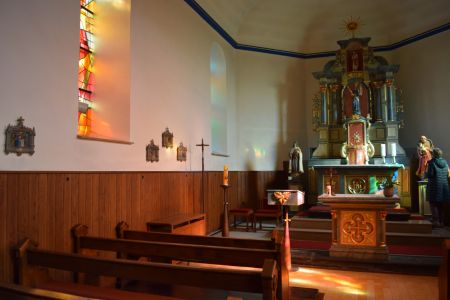Church | | | Catholic Church
Map
Opening hours
15 March - 15 October
Mon 9.00 - 18.00
Tue 9.00 - 18.00
Wed 9.00 - 18.00
Thu 9.00 - 18.00
Fri 9.00 - 18.00
Sat 9.00 - 18.00
Sun 9.00 - 18.00
16 October - 14 March
Mon
Tue
Wed
Thu
Fri
Sat 10.00 - 16.00
Sun 10.00 - 16.00
Description
Before the French Revolution, Leithum, together with Beiler, belonged to the former parish of Weiswampach and thus to the diocese of Liège and the deanery of Stavelot in Belgium until 1802. After Luxembourg became an independent diocese, Leithum and Beiler became a parish of their own. In 1879, the first church was built in Leithum, which was first dedicated to the 14 Helpers in Need and later to the Immaculate Conception. Today, both villages belong to the parish of Ëlwen-Weiswampich Saint François.
Photos
Remarkable elements
Windows
Gustav Zanter designed the stained glass windows in 1988. He opted for an abstract composition. The glass elements in all colors make small points of light dance in the church, depending on the sunlight.
Thérèse of Lisieux
(1873-1897)
Thérèse of Lisieux was canonized in 1925 due to numerous answers to prayer. Her attribute is roses which she holds in her hands; an allusion to a sentence of hers that she would rain roses from heaven after her death.
High altar
It is flanked by the statues of St. Thérèse of Lisieux and St. Joseph with the Child Jesus. Above the tabernacle is the statue of Mary of the so-called Immaculate Conception, whose niche is framed by pairs of columns and floral tendrils.
St. Rosa of Lima
(1586-1617)
Rosa of Lima entered the Third Order of Dominican Sisters at the age of 20 and from then on led a life of penance. Canonised in 1671, she is the first and most important saint of the "New" (Latin American) World.
Mary, Queen of Martyrs with the Fourteen Saints
The so-called "Fourteen Saints" are considered patron saints in times of need, all of whom, except one, died as martyrs. Here they are seen in front of the Blessed Mother, who is also invoked as the Queen of Martyrs.
Immaculate Conception
Mary, the Mother of God, is depicted as the victress over sin, with a globe and a snake, which she tramples with her foot. Because she was preserved from "original sin" at her birth, this depiction is called the "Immaculate Conception".
St. John the Baptist
(ca. 5 BC - 30 AD).














